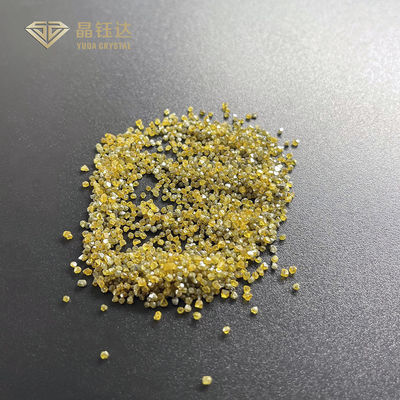1.4-1.6mm Low Grade HPHT Monocrystalline Diamonds For Making Lab Diamond Tools
HPHT Monocrystalline Diamonds Description
Lab diamonds are real diamonds. Carbon is the main element of natural and laboratory-grown diamonds. The chemical and physical properties of synthetic diamonds are same as natural diamonds in terms of hardness, thermal conductivity, and strength.
High temperature and high pressure (HPHT) and chemical vapor deposition (CVD) are the two most commonly used growth methods in synthetic diamonds industrial. The traditional diamond manufacturing method is called the high pressure high temperature (HPHT) method. It uses a device to simulate the high pressure and high temperature conditions of natural diamonds when it is formed underground, and uses carbon materials in the device to produce synthetic diamonds. A relatively new method called chemical vapor deposition (CVD) is to inject carbon-containing gas into a vacuum chamber and deposit its crystals on synthetic diamond seeds. This method requires lower temperature and lower pressure than the high-pressure high-temperature method. Both methods are currently very popular diamond manufacturing methods.
Lab diamond is not only of high commercial value, but also widely used in industry. As the hardest material known to human beings, with the development of science and technology, HPHT Monocrystalline Diamonds is widely used in cermet materials, oil drilling, construction engineering, mechanical processing, instrumentation, electronic industry, aerospace and other fields. The size of diamond is larger and larger, and the purity of diamond is also more and more pure, especially in jewelry, there is a lot of room for development. These synthetic HPHT monocrystalline diamonds have similar properties to natural diamonds and can be produced at a lower cost.
Parameters of HPHT Monocrystalline Diamonds
| HPHT Monocrystalline Diamonds |
| Brand Name |
Yuda Crystal |
| Name |
HPHT Monocrystalline Diamonds |
| Diamond Color |
Yellow |
| Diamond Clarity |
SI-I |
| Diamond Size |
1.4-1.6mm |
| Diamond Cut |
Uncut |
| Polish |
None |
| Symmetry |
None |
| Technology |
HPHT |
| Mesh Size |
8/12 |
| Shape |
Rough |
| Diamond Enhancement |
None |
| Available Type |
HPHT |
| Diamond Certificate |
None |
| Application |
Diamond tools making |
| Place Of Origin |
Zhengzhou, China |
| Delivery Time |
1 - 15 Working Days Base on Order Quantity |
| Payment Terms |
100% Payment In Advance |
| Payment Methods |
T/T, PayPal, Western Union, Bank Transfer |
| Shipping way |
DHL, FedEx, SF Express, UPS, EMS, TNT etc |
| M.O.Q |
Negotiable |
| Diamond Type |
Synthetic(lab created) |
| Location |
Zhengzhou, China |
| Treatments Applied |
None |
| Fire Dispersion |
0.044(Same as Natural Diamond) |
| Brilliance Refraction Index |
2.42(Same as Natural Diamond) |
| Relative Density |
3.52(Same as Natural Diamond) |
| Chemical Composition |
Carbon(Same as Natural Diamond) |
| Moh's Hardness |
10(Same as Natural Diamond) |
HPHT Monocrystalline Diamonds Introduction
Natural diamonds are created by nature and are the result of high temperature and pressure formed over billions of years. The Lab Grown Diamonds are produced in the laboratory, usually in a few weeks. The chemical difference between the two is same.
So how do you distinguish between Lab Grown Diamonds and natural diamonds?
There is no obvious difference between the Lab Grown Diamonds and natural diamonds. Even professional gemologists need special equipment to identify them. By zooming in, professionals will be able to discern subtle contrasts in diamond inclusions grown and mined in the laboratory.
| The Difference Between Lab Diamond And Natural Diamond |
| Properties |
Earth Mined |
Lab Created |
| Guaranteed Conflict-Free |
No |
Yes |
| Hardness (MOHS) |
10 |
10 |
| SP3 Carbon Diamond Bonds (%) |
100% |
100% |
| Internal Crystal Structure |
Face-Centered Cubic |
Face-Centered Cubic |
| Hardness Comparable |
2.42 |
2.42 |
| Relative Diversity |
3.52 |
3.52 |
| Color Diffusion |
0.044 |
0.044 |
| Color |
Various Grades |
K to D grades |
| Price |
$$$$$ |
$$$ |
HPHT Monocrystalline Diamonds Details


 Your message must be between 20-3,000 characters!
Your message must be between 20-3,000 characters! Please check your E-mail!
Please check your E-mail!  Your message must be between 20-3,000 characters!
Your message must be between 20-3,000 characters! Please check your E-mail!
Please check your E-mail! 





